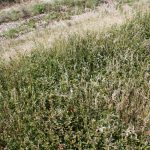Canada bluegrass
Prepared by Jennifer L. D’Appollonio, Assistant Scientist, University of Maine, Orono, ME 04469. Updated February 2018.
Scientific name: Poa compressa L.
Common name(s): Canada bluegrass, flattened meadowgrass, flat-stem bluegrass, flat-stemmed bluegrass
Link(s): USDA PLANTS Profile, Go Botany
Images: (to see enlargements [PC]: click on image, then right click and choose “view image”)
- stem is flattened below inflorescence
- late August
Description:
– perennial
-Grass Family (Poaceae)
– Culms are 15-20 cm tall
-Sheaths are open,smooth, and flattened
-Leaves are 1-4 mm wide and 2-10 cm long
-inflorescence is a narrow panicle 3-8 cm long
– very similar to P. pratensis (KY bluegrass), but stem is flattened below inflorescence. See Go Botany webpage for P. pratensis
Habitat:
-acidic low fertility soils
-disturbed sites
-roadsides
Agriculture:
-palatable to livestock
-does not produce lots of forage
-small mammals and birds eat the leaves and seeds
-Grasshoppers, plant bugs, stink bugs, skipper caterpillars, moth caterpillars, beetles, and bluegrass bill bugs feed on Canada bluegrass
-documented disease found in Canada bluegrass is oat necrotic mottle virus and a mild or symptom less disease in Canada bluegrass which might be transmitted by a mite
Natural History:
-native to Europe
-introduced in Canada in the 1700s
Acknowledgement(s):
St. John, L., D. Tilley, and S. Winslow. 2012. Plant guide for Canada bluegrass (Poa compressa) USDA-Natural Resources Conservation Service, Plant Materials Center, Aberdeen, Idaho 83210.
Eric T. Doucette, Ph.D. – Assistant Professor of Biology, MA College of Liberal Arts, North Adams, MA (updated Feb 2018)






